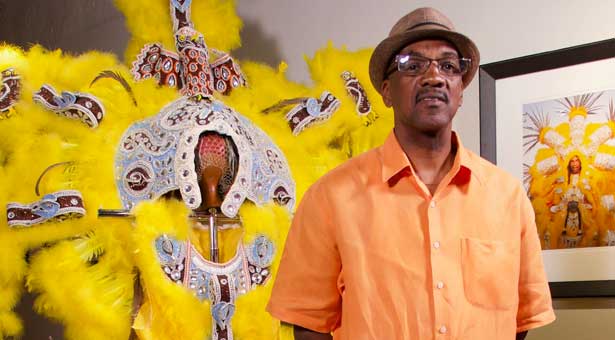
Born in New Orleans, Walter”Sugarbear”Landry is Big Chief of the Black Mohawk Indigenous Black Masking Indian Tribe. Known as a ‘3rd Ward Warrior Jackson Street Soldier’, Landry has a four generation family tribe. Landry has been masking since the 1950’s.
TRIBE TIMELINE:
• From 2007-Present /Big Chief Walter “Sugarbear” Landry /Black Mohawk
• From 1956-2006 /Tribe Disbanded
• From 1950-1955 /Big Chief Frank Royal /Black Mohawk.
• From 1945-1950 /Big Chief Eddie “Coonow” Perkins /Shrewsbury Blues.
• From 1938-1945 /Big Chief Chick Webb /Shrewsbury Blues.
• From 2007-Present /Big Chief Walter “Sugarbear” Landry /Black Mohawk
• From 1956-2006 /Tribe Disbanded
• From 1950-1955 /Big Chief Frank Royal /Black Mohawk.
• From 1945-1950 /Big Chief Eddie “Coonow” Perkins /Shrewsbury Blues.
• From 1938-1945 /Big Chief Chick Webb /Shrewsbury Blues.
Traditionally Black Masking Culture is passed down from generation to generation. Landry however, took a non-traditional route. “I first saw an Indian suit on my grandmother’s friend. It was bright orange and I will never forget it”. When Landry was young his family moved from New Orleans to Shrewsbury where he met Spy Boy Uncle Bubble of the Black Mohawk Tribe. Landry said, “I saw all of his intricately designed suits and man I tripped out and said I WANNA BE AN INDIAN!” At that point Landry began his Indigenous Black Masking journey.
The Black Mohawk Tribe began as the Shrewsbury Blues in the 1930’s. Before Landry moved to Shrewsbury the young people masking in the area needed to learn more about Indigenous Black Masking Culture. With the help of the community and sponsors like Eddie Campus who owned the Shrewsbury Blues Bar where Indian Tribal Custom rehearsals were held, Indians were bussed in from New Orleans to teach traditions such as song, beading, and headdress making. Landry said, “In the early days when the headdresses were brought in to Shrewsbury we had to take them apart and piece them back together until we learned how to create our own”.
In the early 50’s the Shrewsbury Blues Tribe disbanded and Landry met Robbie who was at the time the Big Chief of the Golden Arrows. Robbie took Landry under his wing and added depth and texture to Landry’s masking knowledge. On August 8th, 1961 Landry joined the US Army and was stationed in Berlin during the Cold War till 1963. Landry said, “Missing Mardi Gras was the toughest part of being away. I remember wishing I was home with family and friends sewing and preparing to mask for Carnival”. When Landry returned to New Orleans from his military tour in Berlin, he masked for a few years as the Spy Boy and Flag Boy for the Golden Arrows Tribe.
After three years of military service Landry entered into the next chapter of his life, Fatherhood. “My first daughter was born in 64’, in 65’ my oldest son was born around the time of Hurricane Betsy, in 66’ my second son was born, 2 daughters were born in 69, in 83’ my third son was born, and in 88’ my fourth girl was born, so I needed to go out and make hay while the sun shined”, said Landry. For decades to come, Landry stepped away from the hands-on of masking and operated as a council member educating his family to preserve Black Masking Culture. Landry took on a career as a truck driver to support his family as they grew of age to begin masking on their own.
“My children first masked with the Cheyenne Hunters in 1996 under Big Chief Curtis Williams. In 1997, they masked with the White Eagles under Big Chief Jake. In 1998, my daughter was Big Queen with the Young Cheyennes under Big Chief Bo Dean until 2000. In 2007, I resurfaced as Big Chief of the Black Mohawk Tribe and I’ve been going strong since then.”
Q&A
1. How did you develop your style of sewing?
I was involved at the age of 9 and got help from several people throughout my years. In 1953 my family moved out of Orleans Parish into Jefferson Parish where I met Uncle Bubble and he was the Spy Boy of the Black Mohawks. He taught me the basics. Every day after school I’d finish my homework and my father would drop me off at Uncle Bubbles house from 4p-8p, and on Saturday I would go early and stay there all day to learn how to sew. Around 1958 I met Robbie who was Big Chief of the Golden Arrows. Before I met Robbie I was using the traditional second hand materials to create my suit. I was primitive compared to Robbie and the Indians Masking in New Orleans who taught me to use elaborate sequins, beads, and feathers.
1. How did you develop your style of sewing?
I was involved at the age of 9 and got help from several people throughout my years. In 1953 my family moved out of Orleans Parish into Jefferson Parish where I met Uncle Bubble and he was the Spy Boy of the Black Mohawks. He taught me the basics. Every day after school I’d finish my homework and my father would drop me off at Uncle Bubbles house from 4p-8p, and on Saturday I would go early and stay there all day to learn how to sew. Around 1958 I met Robbie who was Big Chief of the Golden Arrows. Before I met Robbie I was using the traditional second hand materials to create my suit. I was primitive compared to Robbie and the Indians Masking in New Orleans who taught me to use elaborate sequins, beads, and feathers.
2. What are the earliest traditions you remember?
a. I remember using bottle caps, glitter, fish scales, mirrors, fabric off the junkman’s truck, and chicken feathers from the butcher. Back then it wasn’t about money it was about finding the stuff and putting the suit together. The suit came out of your creativity. Back then you could do wonders with old furs, fabric dye, mirrors, glitter, fish scales, carnival beads, glue, and number 8 thread that’s black or white.
a. I remember using bottle caps, glitter, fish scales, mirrors, fabric off the junkman’s truck, and chicken feathers from the butcher. Back then it wasn’t about money it was about finding the stuff and putting the suit together. The suit came out of your creativity. Back then you could do wonders with old furs, fabric dye, mirrors, glitter, fish scales, carnival beads, glue, and number 8 thread that’s black or white.
3. What was the Black Masking experience like during Carnival in the 1950s?
a. We would leave Shrewsbury on three school buses and meet with Big Chief Buddy Wilson of the Red, White, and Blue Tribe off Carrolton and unite our tribes to parade together. Then we would get on a bus and head back to Shrewsbury and parade through the streets. I wouldn’t do that much walking at gun point these days. We were so tired then, we would sleep for a whole day afterwards. The route was so long my mom and sister’s feet hurt for a year!
a. We would leave Shrewsbury on three school buses and meet with Big Chief Buddy Wilson of the Red, White, and Blue Tribe off Carrolton and unite our tribes to parade together. Then we would get on a bus and head back to Shrewsbury and parade through the streets. I wouldn’t do that much walking at gun point these days. We were so tired then, we would sleep for a whole day afterwards. The route was so long my mom and sister’s feet hurt for a year!
4. What major transformation have you seen in your 40+ years of experience masking?
a. When I first got started our neighborhoods came together and we paraded within our communities. Back then you couldn’t pay White people to come around us. They thought we were dangerous. There has been a cultural shift, a sight to behold. Now, White people are rubbing shoulders with us, filming the experience, and they even know the Indian songs better than some locals.
a. When I first got started our neighborhoods came together and we paraded within our communities. Back then you couldn’t pay White people to come around us. They thought we were dangerous. There has been a cultural shift, a sight to behold. Now, White people are rubbing shoulders with us, filming the experience, and they even know the Indian songs better than some locals.
Recommended For You.

Eric Connerly Data News Weekly Contributor
New Orleans is set to receive almost $50 million in federal funding to counteract pollution



Be the first to comment